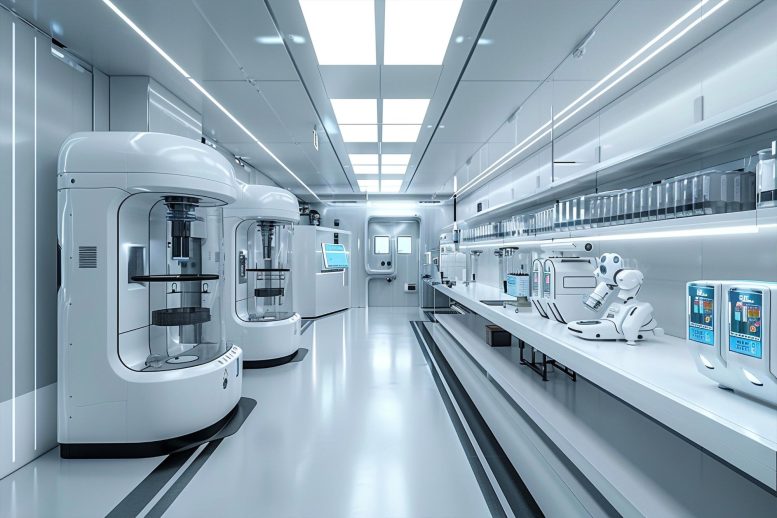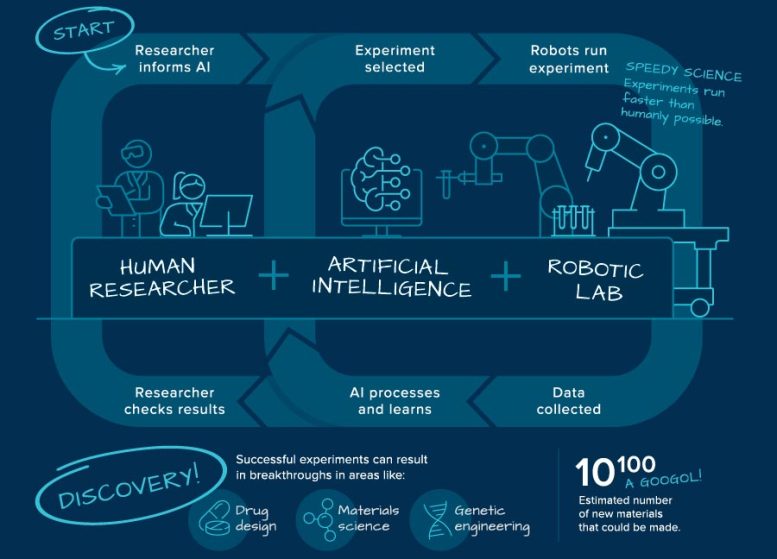
Autonomous discovery at Argonne National Laboratory leverages AI, machine learning, and robotics to accelerate scientific research in areas like climate change, health, and energy, transforming problem-solving from years to mere days or weeks, enhancing safety, and maintaining human creativity at the innovation’s core. Credit: SciTechDaily.com
What Is Autonomous Discovery?
Have you ever pulled an “all-nighter” trying to finish a big project or homework assignment? By dawn, your brain was probably fried. But robots don’t get tired. Artificial intelligence doesn’t need coffee. They can keep working on a problem 24/7.
That’s why researchers at the U.S. Department of Energy’s Argonne National Laboratory are pioneering the next generation of scientific experimentation. It’s called autonomous discovery, and it harnesses the power of robotics, machine learning, and artificial intelligence (AI) to solve big problems in climate, human health, and energy faster than ever before. No robot coffee required.
In this part of our series, computer scientist Casey Stone and Division Director for the Center for Argonne National Laboratory’s Nanoscale Materials Ilke Arslan provide an inside look into autonomous discovery. Autonomous discovery is a process that harnesses the power of robotics, artificial intelligence, and machine learning to bring scientific breakthroughs to the world faster than ever before. Autonomous discovery is revolutionizing the way people do science. Moving forward, these processes will help scientists find solutions that will keep people safer, healthier, and more resilient to the impacts of climate change.
Let’s say you have a problem like plastic pollution, and you need a new type of plastic that is easier to recycle or reuse. There are thousands of possible polymers that might work, and there are potentially harmful chemicals involved in the testing process. In the past, we might have had several researchers working at a lab bench to test one polymer at a time. And that process would take years.
With autonomous discovery, human researchers turn the problem over to robotics and AI. The researchers use a process called machine learning to train the AI with huge data sets. This gives the AI information on everything we already know about plastic recycling, chemical processes, and potential polymer structures. The AI uses that information to make the best decision about which experiments to run next.
Robotic arms and sampling machines run twenty-four hours a day, keeping researchers safely away from chemicals or other potential risks. With machine learning, AI gets smarter as it goes, looking for new patterns and new experiments to run.
Human scientists are free to use their big, creative brains to interpret and act on the most interesting results. Autonomous discovery will help scientists find solutions to complex problems in a matter of days or weeks instead of years or lifetimes.
Human ingenuity and imagination remain at the heart of this innovation. Argonne’s scientists and technicians are finding creative ways to apply the tools of autonomous discovery:
- We’re creating “digital twins” of labs. These virtual-reality models help researchers test machines and figure out the best way to install equipment in real-life biology and chemistry labs.
- We’re exploring everything from new treatments for drug-resistant bacteria to how plants store carbon in the soil.
- We’re building and deconstructing polymer chains to find new ways to recycle and upcycle plastics.
- We’re using some of the world’s fastest supercomputers to run the AI and process data coming from large-scale experiments.
Autonomous labs are helping bring scientific solutions into our lives with never-before-seen speed, efficiency and accuracy. This will not just revolutionize the way we do science; it will propel us into a new era of discovery.

Credit: Argonne National Laboratory
What Is Autonomous Discovery?
A new way of doing science that will bring discoveries to light faster than ever before.
The human brain is an amazing science-solving machine, but the human body can only solve problems for so long before a human researcher needs to eat or sleep. Today’s biggest challenges, like climate change, emerging diseases, and plastic pollution won’t wait for us to grab a sandwich or take a nap. We need answers now. That’s why scientists are getting an assist from robotics, artificial intelligence (AI), and machine learning.
We define a problem. AI identifies, sets up, and runs hundreds of experiments using robotic systems that can work the problem 24/7. With machine learning, AI gets smarter as it goes, looking for new patterns and new experiments to run. Human scientists are free to use their big, creative brains to interpret and act on the most interesting results. Autonomous discovery will bring solutions to us 100× or even 1000× faster.


